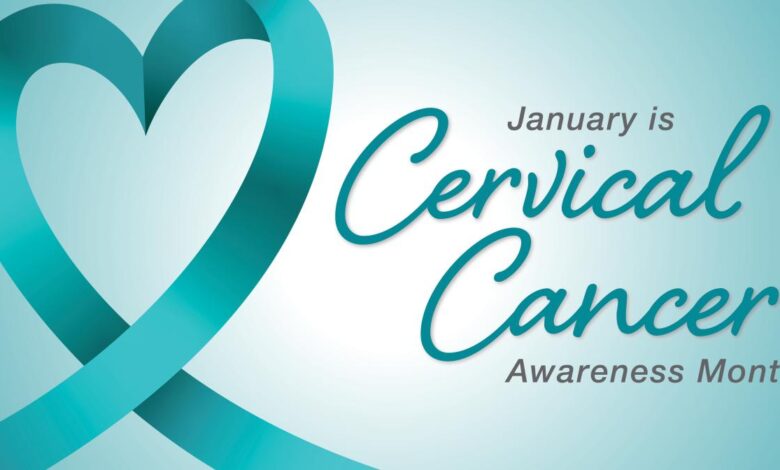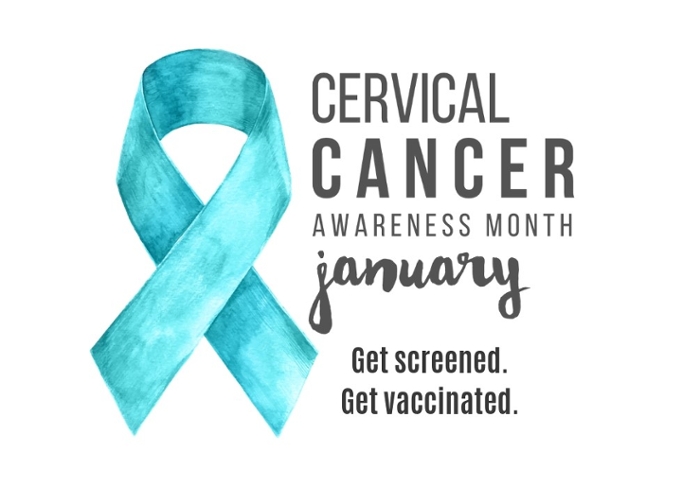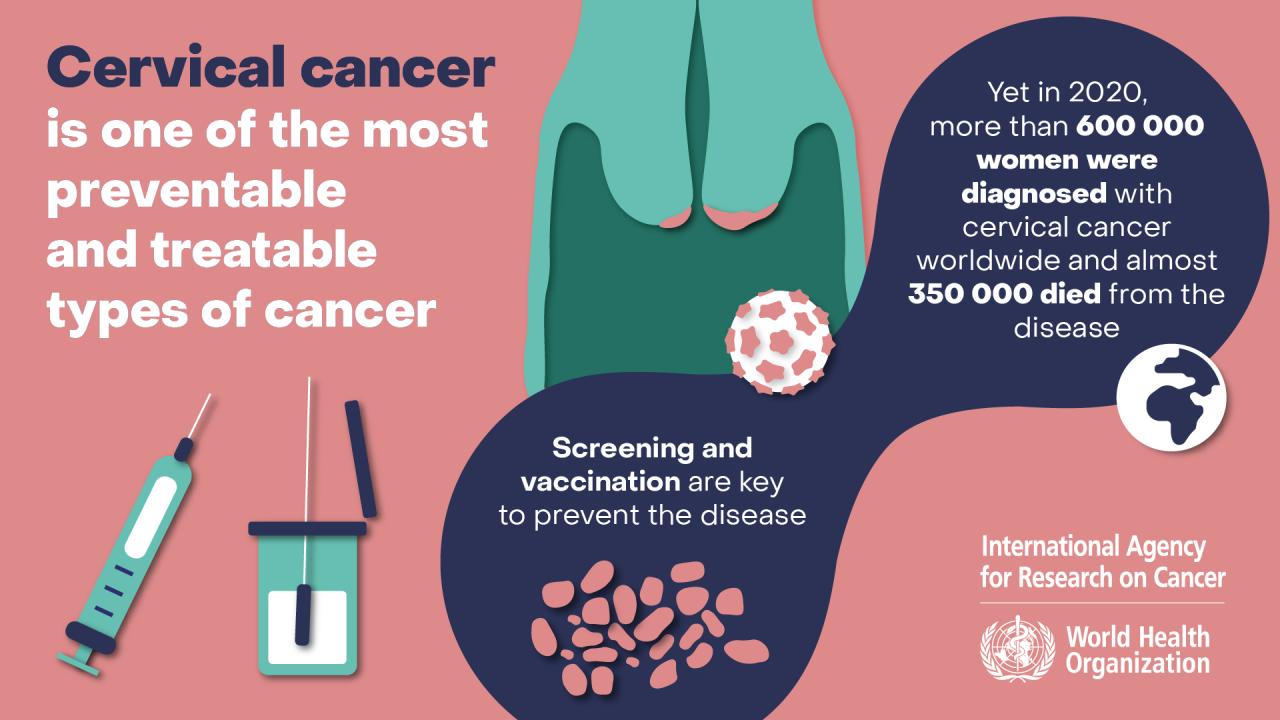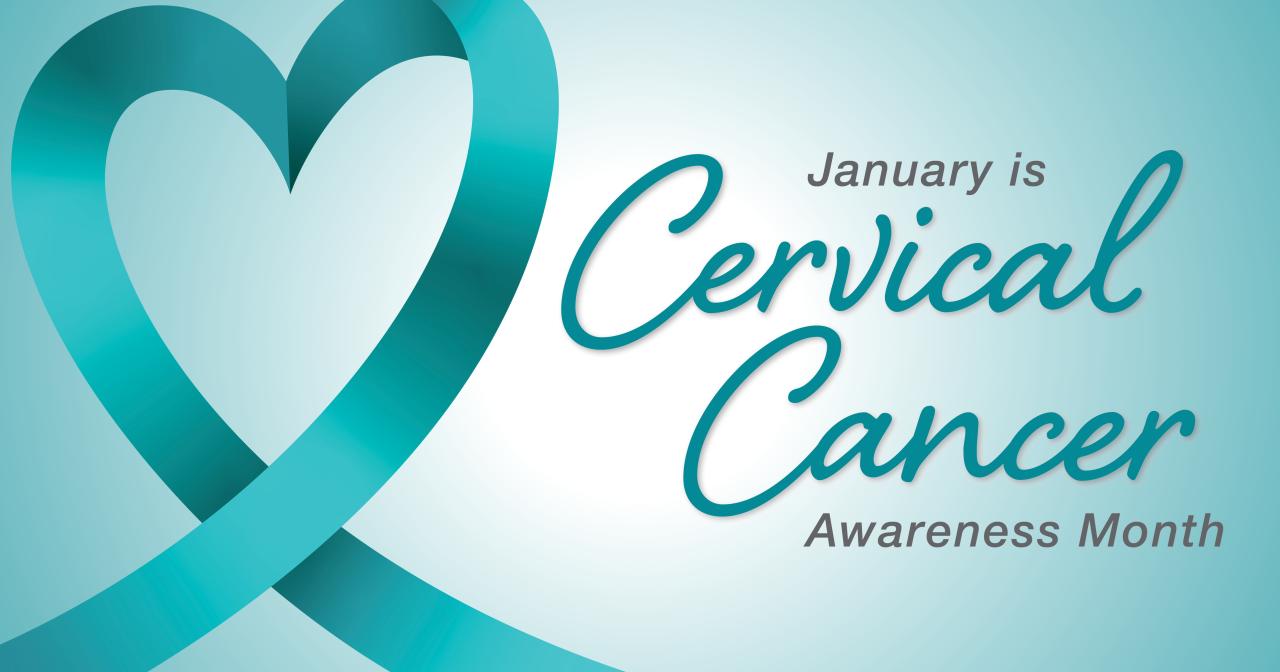
Cervical Cancer Awareness Month Signs & Prevention
Cervical cancer awareness month signs and prevention: It’s a topic many of us shy away from, but understanding the risks and recognizing the signs could be life-saving. This isn’t just about statistics; it’s about empowering ourselves and the women in our lives with knowledge. Let’s dive into understanding cervical cancer, its prevention, and why early detection is so crucial.
We’ll explore the signs, symptoms, and the vital role of regular checkups. This isn’t a scary story; it’s a guide to proactive health.
This month, let’s make a conscious effort to learn more about cervical cancer. We’ll cover everything from the different types and stages of the disease to the importance of the HPV vaccine and regular screenings. We’ll also discuss lifestyle choices that can help reduce your risk, and where to find support if you or someone you know needs it.
Remember, knowledge is power, and early detection significantly improves outcomes.
Understanding Cervical Cancer
Cervical cancer, a disease affecting the cervix (the lower part of the uterus), is a significant global health concern. Understanding its various types, stages, risk factors, and treatment options is crucial for effective prevention and management. Early detection and treatment significantly improve the chances of survival.
Types of Cervical Cancer
Cervical cancer is primarily categorized into two main histological types based on the cells of origin: squamous cell carcinoma and adenocarcinoma. Squamous cell carcinoma arises from the squamous cells that line the cervix’s outer surface, representing the most common type. Adenocarcinoma originates from the glandular cells lining the cervix’s inner canal. Rarely, other types, such as neuroendocrine carcinomas, may also occur.
The specific type influences treatment strategies and prognosis.
Stages of Cervical Cancer Progression
Cervical cancer progression is staged using a system that reflects the extent of the cancer’s spread. Stage I indicates cancer confined to the cervix. Stage II involves spread beyond the cervix but still within the pelvis. Stage III signifies spread to the pelvic wall or lower third of the vagina. Stage IV represents the most advanced stage, with distant metastasis (spread to other organs).
Staging is crucial for determining appropriate treatment plans and predicting outcomes. Early detection, often through Pap smears and HPV testing, is vital for identifying the cancer in its early, more treatable stages.
Risk Factors for Cervical Cancer
Several factors increase the risk of developing cervical cancer. Persistent infection with high-risk types of human papillomavirus (HPV) is the most significant risk factor. Other risk factors include early age at first sexual intercourse, multiple sexual partners, smoking, weakened immune system (e.g., due to HIV infection), and a family history of cervical cancer. Understanding these risk factors allows for proactive measures such as HPV vaccination and regular cervical cancer screening.
Cervical Cancer Treatment Options
Treatment options for cervical cancer vary depending on the stage, type, and overall health of the patient. A multidisciplinary approach often involves surgery, radiation therapy, chemotherapy, or a combination of these modalities.
| Treatment Type | Description | Stage Applicability | Side Effects |
|---|---|---|---|
| Surgery | Removal of the cervix (conization, hysterectomy) or other affected tissues. | Early stages | Bleeding, infection, pain |
| Radiation Therapy | Using high-energy radiation to kill cancer cells. | Various stages | Fatigue, nausea, skin irritation |
| Chemotherapy | Using drugs to kill cancer cells. | Advanced stages | Hair loss, nausea, vomiting, fatigue |
| Targeted Therapy | Drugs that target specific molecules involved in cancer growth. | Advanced stages, recurrent disease | Varies depending on the specific drug |
Recognizing the Signs and Symptoms
Early detection is crucial for successful cervical cancer treatment. Many women experience no symptoms in the early stages, highlighting the importance of regular screenings. However, recognizing potential warning signs can prompt timely medical intervention. Understanding these symptoms, both common and subtle, empowers women to take control of their health.Early symptoms of cervical cancer are often vague and easily dismissed, making awareness paramount.
The progression of the disease and the individual’s overall health can influence symptom presentation. What might be a minor inconvenience for one person could be a more serious indicator for another. It’s vital to consult a healthcare professional if you experience any persistent or concerning changes.
Common Signs and Symptoms
It’s important to remember that these symptoms are not exclusive to cervical cancer and can be caused by other, less serious conditions. However, persistent symptoms warrant a medical evaluation.
- Abnormal vaginal bleeding: This includes bleeding between periods, after sex, or post-menopause. The bleeding might be light spotting or heavier than a normal period.
- Unusual vaginal discharge: A change in the color, odor, or amount of vaginal discharge can be a warning sign. This might include a discharge that is watery, foul-smelling, or bloody.
- Pelvic pain or pressure: A persistent aching or pressure in the pelvis might indicate a problem. This pain can range from mild discomfort to severe cramping.
- Pain during sexual intercourse (dyspareunia): Discomfort or pain experienced during sex could be a sign of underlying issues.
Less Common or Subtle Symptoms
Some symptoms are less frequently reported and can easily be overlooked, emphasizing the importance of regular checkups and open communication with your doctor.
- Fatigue: Unexplained and persistent tiredness can be a symptom of many health issues, including cancer.
- Weight loss: Significant unintentional weight loss can be a sign of underlying disease.
- Leg pain or swelling: In advanced stages, the cancer may spread to the lymph nodes, causing leg pain or swelling.
- Back pain: Pain in the lower back can be a symptom in later stages of cervical cancer.
Symptoms by Stage, Cervical cancer awareness month signs and prevention
The symptoms experienced often correlate with the stage of the cancer. Early-stage cervical cancer may not produce any noticeable symptoms, making regular screenings crucial. As the cancer progresses, symptoms become more pronounced and may include those listed above, with increasing severity. For example, early stages might only show abnormal bleeding, while later stages could involve significant pelvic pain and leg swelling.
This underscores the importance of early detection.
October is Cervical Cancer Awareness Month, reminding us of the importance of regular screenings and preventative measures like the HPV vaccine. It’s fascinating to consider how early detection plays a role in other health concerns too; research suggests that, as reported in this article, can eye test detect dementia risk in older adults. This highlights the significance of proactive healthcare across the board, emphasizing the need for both cervical cancer awareness and regular check-ups for other age-related conditions.
Prevention and Early Detection: Cervical Cancer Awareness Month Signs And Prevention
Cervical cancer, while a serious disease, is largely preventable and treatable when detected early. This section focuses on the crucial steps women can take to protect themselves and ensure their health. Early detection through regular screenings is key to improving survival rates and reducing the impact of this cancer.
October is Cervical Cancer Awareness Month, reminding us of the importance of regular screenings and healthy lifestyle choices for prevention. It’s all about proactive health, much like Karishma Mehta’s decision to freeze her eggs, as detailed in this article karishma mehta gets her eggs frozen know risks associated with egg freezing , highlighting the importance of understanding risks associated with major health decisions.
Taking control of your health, whether it’s cervical cancer prevention or family planning, is key to a healthier future.
Regular screenings are your best defense against cervical cancer. They allow for the early identification of precancerous changes, meaning abnormalities in the cells of the cervix that, if left untreated, could develop into cancer. Early detection dramatically increases the chances of successful treatment and a positive outcome.
Pap Smears and HPV Testing
Pap smears and HPV tests are vital components of cervical cancer screening. A Pap smear examines cells from the cervix for abnormalities. HPV testing detects the presence of human papillomavirus (HPV), a sexually transmitted infection that causes most cervical cancers. While a Pap smear looks for abnormal cells, HPV testing identifies the virus itself, providing a more comprehensive assessment of risk.
Often, these tests are performed together to maximize detection accuracy. The frequency of these tests depends on age and individual risk factors, and your healthcare provider can advise you on the appropriate schedule for your specific situation.
The Role of the HPV Vaccine
The HPV vaccine is a significant breakthrough in cervical cancer prevention. This vaccine protects against the high-risk types of HPV that are responsible for the vast majority of cervical cancers. The vaccine is most effective when administered before a person becomes sexually active. While the vaccine doesn’t protect against all types of HPV, it significantly reduces the risk of developing cervical cancer and other HPV-related cancers.
It’s important to note that even if vaccinated, regular screenings remain crucial for early detection.
Lifestyle Choices to Reduce Cervical Cancer Risk
Several lifestyle choices can contribute to a lower risk of developing cervical cancer. These choices are not guarantees, but they significantly impact your overall health and well-being.
Making healthy choices is crucial in reducing your risk of developing cervical cancer. These lifestyle changes are not foolproof, but they can significantly improve your chances of staying healthy.
- Safe Sex Practices: Practicing safe sex, including using condoms consistently and limiting the number of sexual partners, significantly reduces your exposure to HPV.
- Regular Cervical Cancer Screenings: Adhering to recommended screening schedules, as advised by your healthcare provider, is paramount for early detection.
- Maintaining a Healthy Immune System: A strong immune system is better equipped to fight off infections, including HPV. This can be achieved through a balanced diet, regular exercise, and adequate sleep.
- Avoiding Smoking: Smoking significantly increases the risk of many cancers, including cervical cancer. Quitting smoking is a vital step towards improving your overall health.
Cervical Cancer Screening Steps: An Infographic Description
The infographic would visually represent the steps involved in cervical cancer screening. It would begin with a section explaining the importance of regular check-ups and the recommended age to start screenings. A flowchart would then illustrate the process, starting with scheduling an appointment with a gynecologist. The next step would be a description of the Pap smear and/or HPV test, possibly including a simple illustration of the procedure.
The infographic would then show the results interpretation, indicating what happens if results are normal or abnormal. If abnormal, the next steps would be illustrated, including further testing and potential treatment options. Finally, the infographic would emphasize the importance of follow-up appointments and ongoing monitoring. The overall tone would be reassuring and informative, emphasizing the ease and importance of regular screenings.
Cervical Cancer Awareness Month Activities
January is Cervical Cancer Awareness Month, a crucial time to raise awareness and encourage preventative measures. Effective campaigns require a multi-pronged approach, targeting diverse age groups and utilizing various communication channels. Success hinges on clear, accessible information and engaging strategies that resonate with the target audience.
Awareness Campaign Ideas for Cervical Cancer Awareness Month
A successful awareness campaign needs a variety of activities to reach a wide audience. These initiatives should be designed to educate, empower, and motivate individuals to prioritize their cervical health.
- Public Service Announcements (PSAs): Create short, impactful videos or radio spots featuring real women sharing their stories or healthcare professionals explaining the importance of screenings. These PSAs could air on local television and radio stations, as well as online platforms.
- Community Events: Organize free screenings or educational workshops in partnership with local clinics and community centers. These events can offer valuable information, resources, and potentially life-saving screenings.
- School Programs: Develop age-appropriate educational materials for schools, focusing on healthy sexual practices and the importance of regular checkups starting in young adulthood.
- Social Media Challenges: Launch a social media campaign with a catchy hashtag encouraging people to share their commitment to cervical cancer prevention, including information on screenings and vaccination.
- Partnerships with Influencers: Collaborate with health and wellness influencers to spread awareness through their social media channels. This can help reach a wider audience, especially younger demographics.
Communicating Cervical Cancer Prevention to Different Age Groups
Tailoring messages to specific age groups is vital for effective communication. Different age groups have varying levels of understanding, concerns, and access to healthcare.
January is Cervical Cancer Awareness Month, reminding us of the importance of regular screenings and healthy lifestyle choices. A key part of that is nutrition, and understanding how our bodies utilize nutrients is crucial. This is why I found the article on are women and men receptive of different types of food and game changing superfoods for women so insightful, as it highlights the impact of diet on overall health, which is intrinsically linked to cancer prevention.
Knowing what superfoods best support women’s health can be a powerful tool in our fight against cervical cancer and other diseases.
- Teens and Young Adults (13-25): Focus on HPV vaccination, healthy sexual practices, and the importance of regular checkups once sexually active. Use relatable language and visuals in social media campaigns.
- Adults (26-45): Emphasize the importance of regular Pap smears and HPV tests, highlighting the ease and accessibility of these screenings. Address common concerns and misconceptions about these procedures.
- Older Adults (45+): Continue to stress the importance of regular screenings, even after menopause. Address any barriers to access, such as transportation or cost, and offer solutions.
Examples of Successful Past Awareness Campaigns
Several successful campaigns have demonstrated the power of effective communication in raising awareness about cervical cancer. For example, the “Smear for Life” campaign in Australia used powerful imagery and celebrity endorsements to encourage women to get screened. Similarly, the “HPV Vaccine Awareness Campaign” in several countries effectively promoted the benefits of HPV vaccination among young girls and boys.
These campaigns successfully increased screening rates and HPV vaccination uptake, demonstrating the impact of targeted and engaging campaigns.
Social Media Campaign Strategy for Promoting Cervical Cancer Awareness
A strong social media strategy is crucial for reaching a broad audience. This requires a well-defined plan encompassing several key elements.
- Hashtag Development: Create a unique and memorable hashtag to track campaign engagement and unify conversations.
- Content Calendar: Develop a content calendar outlining the types of posts, visuals, and messaging to be shared throughout the month. This ensures consistent and strategic communication.
- Targeted Advertising: Utilize social media advertising to reach specific demographics based on age, location, and interests. This helps maximize the impact of the campaign.
- Influencer Marketing: Partner with relevant influencers to extend the reach of the campaign and build trust among the target audience.
- Interactive Content: Engage the audience through interactive content such as polls, quizzes, and Q&A sessions to increase participation and knowledge retention.
Seeking Medical Help and Support

Source: floridahealth.gov
Facing potential cervical cancer or a diagnosis can be overwhelming, but knowing where to turn for help is crucial. This section Artikels the resources available to women concerned about cervical cancer, detailing the process of seeking medical attention and highlighting support systems available during this challenging time. Remember, early detection and appropriate support are key to navigating this journey.
If you experience any symptoms that concern you – abnormal vaginal bleeding, pelvic pain, unusual vaginal discharge, or persistent lower back pain – it’s vital to seek medical attention promptly. Don’t delay; early diagnosis significantly improves treatment outcomes. The process usually begins with a visit to your primary care physician or a gynecologist. They will conduct a thorough examination, possibly including a Pap smear and pelvic exam.
Further investigations, such as a colposcopy (a magnified examination of the cervix) or a biopsy (removal of a tissue sample for examination), may be recommended depending on the findings. Open communication with your doctor is essential throughout this process to ensure you understand the next steps and have your questions answered.
Available Resources for Women Concerned About Cervical Cancer
Numerous resources exist to provide information, support, and assistance to women facing cervical cancer. These range from national organizations dedicated to cancer research and patient advocacy to local support groups offering peer-to-peer connection and emotional support. These resources can help navigate the complexities of diagnosis, treatment, and recovery.
Seeking Medical Attention for Cervical Cancer Symptoms
The process of seeking medical attention involves several steps, starting with recognizing potential symptoms and contacting your healthcare provider. This should involve a frank discussion of your symptoms, medical history, and any concerns you may have. Your doctor will then conduct a physical examination, order necessary tests, and provide a diagnosis and treatment plan. Throughout this process, it’s important to maintain open communication with your medical team to ensure you understand your options and feel comfortable with the course of action.
Support Groups and Organizations Offering Assistance
Facing a cervical cancer diagnosis can be emotionally and mentally challenging. Support groups and organizations provide invaluable assistance by offering a safe space to share experiences, connect with others undergoing similar journeys, and receive emotional support. These groups can also provide practical advice and resources to help manage the challenges of treatment and recovery. Some organizations offer online support forums, allowing individuals to connect from anywhere, fostering a sense of community and shared understanding.
- The American Cancer Society: Offers a wide range of resources, including information, support groups, and financial assistance programs.
- The National Cancer Institute: Provides comprehensive information on cancer research, treatment, and prevention.
- Local hospitals and cancer centers: Often have dedicated support groups and resources for cancer patients and their families.
Financial Assistance Programs for Cervical Cancer Treatment
The cost of cervical cancer treatment can be substantial. Fortunately, several financial assistance programs exist to help alleviate the financial burden. These programs may cover treatment costs, medication, transportation, and other expenses associated with cancer care. Eligibility criteria vary depending on the program, so it’s essential to research and apply to those that best fit your individual circumstances.
- The Patient Advocate Foundation: Helps patients navigate the complexities of healthcare financing and access financial assistance programs.
- The Cancer Support Community: Provides various resources, including financial assistance programs, to help cancer patients and their families.
- Hospital-based financial assistance programs: Many hospitals offer financial aid to patients who are unable to afford their treatment.
- State and local programs: Some states and local organizations offer financial assistance for cancer treatment. It’s crucial to research programs available in your specific area.
The Role of HPV

Source: who.int
Human papillomavirus (HPV) is a very common virus, and its role in cervical cancer is undeniable. Almost all cases of cervical cancer are linked to persistent HPV infection. Understanding this link is crucial for prevention and early detection.The connection between HPV and cervical cancer isn’t a simple one-to-one relationship; it’s a complex interplay of factors. While most people infected with HPV clear the virus naturally within a couple of years, persistent infection with certain high-risk types can lead to precancerous changes that, if left untreated, can progress to cancer.
HPV Types and Cancer Risk
There are many different types of HPV, some of which are low-risk and cause genital warts, while others are high-risk and are strongly associated with cervical cancer. High-risk types, such as HPV 16 and 18, are responsible for the vast majority of cervical cancers. Other high-risk types, while less prevalent, still contribute to the risk. The presence of high-risk HPV is a significant indicator for cervical cancer screening and management.
The persistent presence of these high-risk HPV types is what distinguishes it from transient infection, which is far more common.
Effectiveness of the HPV Vaccine
The HPV vaccine is highly effective in preventing infection with the high-risk HPV types that cause most cervical cancers. The vaccine works by training the body’s immune system to recognize and fight off these specific HPV types before they can cause an infection. Studies have shown significant reductions in HPV-related precancerous lesions and cervical cancer in populations with high vaccination rates.
The vaccine is most effective when administered before sexual activity begins, ideally in adolescence. However, even vaccination in later years can still offer some protection.
Long-Term Effects of HPV Infection: Vaccination vs. No Vaccination
For individuals vaccinated against HPV, the long-term effects are overwhelmingly positive. The risk of developing persistent HPV infection with the targeted high-risk types is significantly reduced, thereby lowering the risk of developing cervical cancer and other HPV-related cancers. Those who are not vaccinated, and contract high-risk HPV, face a greater likelihood of persistent infection. This can lead to the development of precancerous lesions requiring ongoing monitoring and treatment, and, in some cases, cervical cancer.
The contrast is stark: vaccination significantly reduces the long-term burden of HPV-related diseases, offering substantial protection against cancer. While not eliminating all risks, it greatly diminishes the probability of developing serious health problems.
Wrap-Up

Source: floridahealth.gov
Taking charge of your health is a powerful act of self-love. Cervical cancer awareness month isn’t just about raising awareness; it’s about empowering women to prioritize their health and seek preventative care. Remember, regular screenings, the HPV vaccine, and a healthy lifestyle are your best allies in preventing this disease. Let’s break the silence, spread the word, and encourage everyone to prioritize their well-being.
Don’t hesitate to share this information with the women in your life – it could save a life.
FAQ Explained
What are the long-term effects of HPV infection if left untreated?
While most HPV infections clear up on their own, some persistent infections can lead to genital warts or, in rare cases, cervical cancer. Regular screenings are key to early detection and treatment.
Is the HPV vaccine safe?
Yes, the HPV vaccine is extensively tested and considered safe and effective. Like any vaccine, it may cause mild side effects, but serious side effects are rare.
How often should I get a Pap smear?
The recommended frequency of Pap smears varies based on age and individual risk factors. Consult your doctor for personalized recommendations.
Can men get HPV?
Yes, men can get HPV, though they don’t typically develop cervical cancer. They can still transmit the virus to women.





